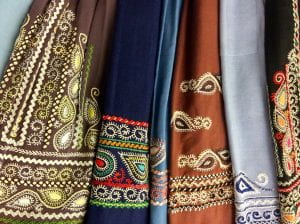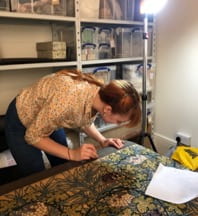PhD student Jayne Knight reflects on a curious find on a trip to a seaside town.
I first spotted Folkestone in a Crab in the shop window of Rennies Seaside Modern, in the Kentish town of Folkestone. At first glance it was hard to determine what it was; the crab shaped object lay flat and its interior was hidden, presented in the window display alongside other curious collectables for sale. What exactly was Folkestone in a Crab?
Opening the crab and pulling on its tab, a series of folded photographic images were revealed. Small enough at 13 x 8cm to be posted in an envelope or kept as a small memento of a trip to Folkestone, the fold-out photo souvenir would have been purchased at desirable Victorian and Edwardian seaside locations, sold alongside more standardised picture postcards during their ‘golden age’.
The crab was made by Edward Thomas West Dennis (E.T.W.D., Ltd), a well-known postcard printer and publisher based in Scarborough, and later London. Dennis sold his first picture postcard in 1894, becoming the first to privately publish postcards, a commercial venture made possible by changes in Post Office regulations. At the printworks in Scarborough, Dennis who founded his stationery and printing business in 1870, began printing postcards, both illustrated and photographic, capturing the landmarks and popular views of seaside destinations. Dennis expanded his family business to publish view-books and novelty items and later exported postcards internationally. The company closed in 2000 after 130 years of business.
The crab design was registered by E.T.W.D in 1908, and used as a template for different seaside towns. A second example, Margate in a Crab, identical in format, presented photographic images of another Kent harbour town, both were historically popular with tourists and those seeking the advertised health benefits of seawater bathing. The crab was a design suitable for harbour towns with strong fishing identities, representing one of the town’s main industries and a popular pastime of tourists.
Folkestone’s popularity soared with the Victorians and Edwardians, the grand Victoria Pier, harbour, Leas Lift and the elegant Leas promenade walk that offered views of France on a clear day, were all recognised landmarks of the town. These sights provided postcard publishers with desirable images to be used on their products, ideal for customers wishing to keep such images as souvenirs or to post in an envelope, sharing what Folkestone had to offer as a leisure destination. Many of the landmarks remain unchanged today, with the exception of the pier, having been defined by turn of the century popularity and cultural significance, contributed to by the sharing of popular imagery through postcards and novelty objects such as the crab.
The twelve black and white photographic images folded inside the crab use the more unusual format of the novelty cover to present Folkestone’s landmarks, differing from the more common two-dimensional singular image postcards. The series of images featured were company stock photos, used by postcard publishers to mass produce inexpensive postcards for sale. Unlike postcards, these novelty fold-outs did not have a designated writing space, although blank space was given on the inside cover, instead they relied on the photographs and their presentation as a form of visual communication.
A fascinating object, these mass produced souvenirs are scarcely found in comparison to the number of picture postcards for sale in the realms of online auctions, collectibles shops and flea markets. In part, it can be assumed that they cost more to produce and purchase, resulting in fewer in circulation or because as an object that required physical handling, folding its image component in and out for viewing resulted in wear and tear, and disposal. This example was a gift “from aunty,” as written on the inside cover, its broken paper clasp reattached with tape, perhaps kept in a scrapbook or family collection, a treasured memory of a great day out. Over one-hundred years in age, the crab’s value as an object for exploring photographic souvenir culture is intriguing. This unusually designed photographic souvenir captures Folkestone’s seaside charm and Edwardian culture in one little crab.

































